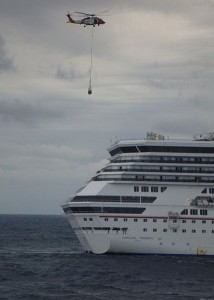 Early Monday morning, the Royal Caribbean cruise ship Grandeur of the Seas caught fire in a mooring area on the back deck of the ship. The crew reacted in time, and all passengers were safely alerted and evacuated from their rooms. The fire spread to at least four decks, but the fire was put out within two hours. Passengers waited around for about four hours, and some had bad reactions to the smoke. But the crew passed out water bottles and attended to the mild injuries reported, the worst of which was one ankle sprain.
Early Monday morning, the Royal Caribbean cruise ship Grandeur of the Seas caught fire in a mooring area on the back deck of the ship. The crew reacted in time, and all passengers were safely alerted and evacuated from their rooms. The fire spread to at least four decks, but the fire was put out within two hours. Passengers waited around for about four hours, and some had bad reactions to the smoke. But the crew passed out water bottles and attended to the mild injuries reported, the worst of which was one ankle sprain.
About seven hours later, the ship reached Freeport in the Bahamas, and passengers were either put up in hotels or sent back to Baltimore, where the trip had begun. To make up for the incident, Royal Caribbean will provide all passengers with a full refund and voucher good for a future trip. Royal Caribbean and the US Coast Guard are investigating the cause of the fire, but it has still not been found.
After all of the bad publicity Carnival Cruises has brought on their industry this year, a fire couldn’t come at a worse time. No one can forget the engine fire that knocked out the power on Carnival Triumph back in February.
 The main difference between these two fires is location. On the Triumph, the fire began in the engine room, which is a cruise ship’s central nervous system. The fire detection system activated immediately, which shut down the ship’s air conditioning and ventilation systems. Then the fire suppression system went into action, which flooded the engine room with chemicals designed to inert the oxygen and starve the fire. The process worked and the fire was put out, but it knocked out everything that operates on fuel, such as the engines and generators.
The main difference between these two fires is location. On the Triumph, the fire began in the engine room, which is a cruise ship’s central nervous system. The fire detection system activated immediately, which shut down the ship’s air conditioning and ventilation systems. Then the fire suppression system went into action, which flooded the engine room with chemicals designed to inert the oxygen and starve the fire. The process worked and the fire was put out, but it knocked out everything that operates on fuel, such as the engines and generators.
Triumph was in essence dead in the water and quickly turned into a floating biohazard. There was no power to operate refrigeration or air conditioning, and most modern ships use electric hydraulic toilets, so waste management became an instant problem. Since passengers still had access to their phones, they could easily upload photos and Tweet about the overflowing sewage, ketchup sandwiches, and three-hour waits for functioning toilets.
Carnival has not always had the best of luck in the past. In November 2010, the Carnival ship Splendor had a fire that knocked out power by melting insulation around electrical cables. The 3,006-passenger ship was towed from Mexico to San Diego by tugboats. Passengers endured three days without air conditioning, hot food, or cabin lighting.
Despite these public fires, traveling on cruise ships is still considered to be safe. While passengers have endured the effects of fires, no fire has caused deaths or serious injury. The fires themselves are contained quickly, but hitting the engines causes serious problems.
Recently, members of the Cruise Lines International Association (CLIA) approved provisions on the Passenger Bill of Rights. While many of these have been standard practices over the years, they are a reassurance to those now wary of disasters on cruise ships. According to CLIA’s website, “Inspections focus on structural fire safety…including fire fighting systems…Additionally, the U.S. Coast Guard observes fire and abandon ship drills conducted by the ships’ crew, and requires satisfactory operational tests of key equipment such as steering systems, fire pumps and bilge pumps.”
Lastly, the rights now protect a passenger’s wallet in the instance of disasters at sea. Passengers now officiallly have the right to a refund if the trip is canceled because of mechanical failures. The Passenger Bill of Rights is now active for US companies and will be applicable internationally by the end of 2013.
For recent issues of cruise safety, check out:
- What Happens When a Cruise Passenger Goes Overboard?
- Is Carnival Cruise Cutting Corners: The Experts Weigh In
- Two Reasons to Buy Travel Insurance for Your Next Cruise
- Post Carnival Triumph: How Safe Is Your Cruise?
By Stephanie Ervin for PeterGreenberg.com












